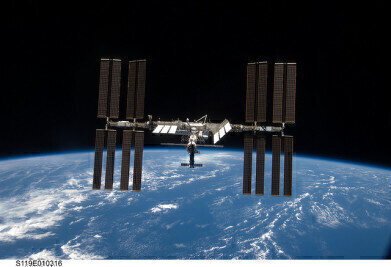News & Views
ISS Marks 15th Anniversary in Space
Nov 15 2015
The International Space Station (ISS) switched into full swing celebration mode late last month. The occasion? Humans have been continuously living on the station for 15 years!
While assembly of the station kicked off in November 1998, it wasn’t until November 2nd 2000 that the first crew arrived. The trio was made up of NASA astronaut and commander William Shepherd, as well as Russian cosmonauts Sergei Krikalev and Yuri Gidzenko. Together they worked to activate several critical life support systems and get the station fully functional.
''There are so many people who felt maybe we couldn't do it,'' stated Daniel Goldin, NASA’s administrator back in 2000. ''But it's happening, it's here. We're going to be in space forever with people who are circling this globe, and then we're going on to Mars, back to the moon and with bases on asteroids.''
15 years of ‘life on Mars’
Since that momentous date, an additional 217 people from 17 countries have visited the station. While no one individual has lived out an entire 15 years on the station, it has been continuously occupied for the entire time.
Today, ISS is manned by two astronauts who are currently six months into a yearlong stay - NASA’s Scott Kelly and Russia’s Mikhail Kornienko. Already they’re provided a wealth of crucial biological data that will pave the way for a series of manned missions to Mars that are set to launch in late 2030. These could last more than two years which will further contribute to the total time the ISS has been inhabited.
Of course, a lot is set to change between then and now, with parts of the ISS scheduled to be deorbited over the coming years. Already, Russia has its sights set on constructing a new space station, however until this comes to light ISS will remain the keystone for space endeavours and explorations.
Interested in finding out more about the space feats that have defined the past few decades? ‘The Role of Materials Degradation and Analysis in the Space shuttle Columbia Accident Investigation’ offers an in-depth analysis of one of the most notorious materials failure programmes ever launched. Several years ago Steve McDanels, manager of NASA’s Failure Analysis and Materials Evaluation Branch at the Kennedy Space Center attended the 2006 Plenary Session Conference to discuss the light and electron microscopy techniques, as well as the associated chemical analysis techniques that NASA scientists are using to determine the causes of 2003’s Space Shuttle Columbia disaster.
Image via Flickr Creative Commons. Credits: Essam
Digital Edition
Lab Asia 31.2 April 2024
April 2024
In This Edition Chromatography Articles - Approaches to troubleshooting an SPE method for the analysis of oligonucleotides (pt i) - High-precision liquid flow processes demand full fluidic c...
View all digital editions
Events
Apr 25 2024 Istanbul, Turkey
Apr 28 2024 Montreal, Quebec, Canada
May 05 2024 Seville, Spain
InformEx Zone at CPhl North America
May 07 2024 Pennsylvania, PA, USA
May 14 2024 Oklahoma City, OK, USA


















